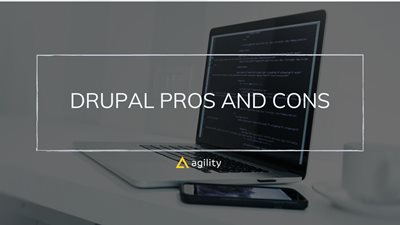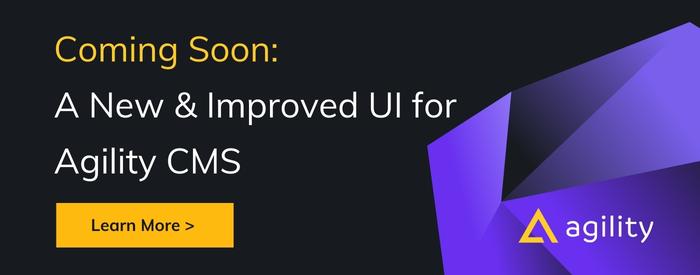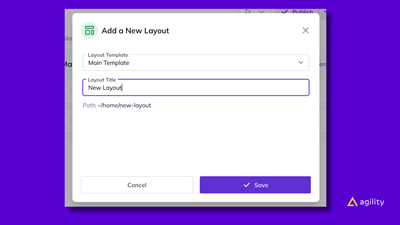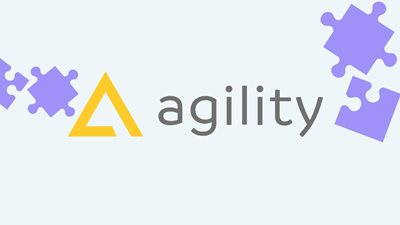Drupal Pros and Cons
And Why A Headless CMS Is Your Best Bet?


There is a constant battle to stay up-to-date in web technology, and a CMS is the foundation stone that helps you win that battle. Many have turned to open-source CMS like Drupal to save money and increase efficiency. Open-source CMS like Drupal to build websites efficiently and cost-effectively. However, platforms like Drupal or WordPress are not the silver bullet that will give you unlimited profit with no investment.
Drupal is a popular content management system for building websites. It's open-source and free, which is, in itself, a great benefit. Yet, there are also disadvantages to using Drupal. It can be challenging to use and is not as user-friendly as other open-source platforms like WordPress or Joomla. Plus, there's the issue of security… or lack thereof.
Choosing the suitable CMS for you is a decision that can't be taken lightly, and an open-source platform like Drupal CMS has its own pros and cons. This article discusses Drupal's pros and cons and why Agility CMS is a solid alternative to Drupal.
Pros of Drupal
Huge User Community
Drupal is an open-source CMS that boasts a significant community. This includes developers and enthusiasts who can help you with minor implementation problems or dispel doubts about building a Drupal website. The Drupal community revolves around a free exchange of ideas. It offers documentation and discussion boards for developers willing to swim the often murky waters of your Drupal implementation.
Prioritizes Accessibility
Accessibility is a crucial component of today's digital experiences. One of the most incredible things about Drupal is its commitment to accessibility. Proper accessibility makes it possible for every user, regardless of their device and capabilities, to have a solid experience. Drupal ensures its features conform to the World Wide Web Consortium guidelines and accessibility features.
Robust Platform
Drupal websites are robust. They provide users with a platform to build a solid design —albeit clunky, in our opinion— website. A Drupal developer can create and modify its website and deliver content to the users in a platform everybody knows.
Cons of Drupal
Security Concerns
The most significant drawback of using Drupal CMS is the inherent security concerns in choosing an open-source platform. In terms of security, though, Drupal leaves a bit to be desired. Any developer remotely familiar with the platform's code could quickly identify security vulnerabilities and carry out cyberattacks. If your site deals with sensitive or personal information, this is something you do not want.
Not Good for Non-Technical Users
Another significant drawback of Drupal websites is how unfriendly it is to non-developers. If you require a feature on Drupal that doesn't already exist as a Drupal module, you'll need to hire a developer to build it. This presents issues for non-technical users who might not be able to use Drupal to its maximum potential.
Plus, on Drupal, it's expensive to develop yourself, meaning that you may not always be able to take advantage of new features that competitors are adopting in this situation.
Hard To Customize
Open-source CMS systems like Drupal and WordPress also pose a challenge for some customization. Drupal doesn't have many modules available for customization; while there are undoubtedly free options, most of the more popular and widely-used ones require an additional fee. Upgrades are often an issue; if they break one of the plugins you're already using, other development work will be required.
There is also the issue that you cannot upgrade a site built with Drupal 6 to Drupal 8. If your site was created with the previous version, you're starting from scratch.
Lack of Support
Many people don't realize that when working with an open-source solution, one of the most immediate problems is lack of support. Since no one owns open-source software, there isn't any company behind it to help you with your support needs. If you need development or aid work, you and your staff will have to handle it —or you have the option to pay costly support from a trusted Drupal partner. However, you can't simply pick up the phone and call someone when you get stuck. If your site goes down, it's up to you and your employees to fix the problem: period, end of the story.
Not So Scalable
Finally, many often find flexibility and scalability two major pain points when working with a solution like Drupal CMS. For instance, if you need to build an API to get your CMS to interact with another solution, you will need to do it yourself —all of which leads to additional costs and resources.
With Drupal, you can only leverage the platform to its full potential through a Drupal partner. Since Drupal development is highly specialized and the technical knowledge required to set up the platform is specific, developing your website can become very costly.
Why a Headless CMS is a better alternative to Drupal?
Contrary to a traditional CMS, a headless content management system is decoupled from the presentation layer, frontend, or head. At the same time, the backend is your content repository and content management system — or the body.
When you separate your content repository "body" from its presentation layer "head," it becomes a headless CMS. Its content-first approach truly makes a headless CMS better than a traditional CMS platform content-first approach. Headless CMS features full APIs to access and display content in any way desired.
With this approach, a headless CMS like Agility CMS enables you to curate your content through the RESTful API and deliver it wherever you need it — not just to a templated website or application. A pure headless CMS doesn't generate any frontend code. It is sometimes referred to as "Content-as-a-Service" (CaaS). This process creates the best available digital experience for the end-users of a particular device. Frontend developers can continue developing new functionality for any channel, independent of the backend.
A headless CMS focuses on delivering and managing content. It stores content in a database and has the range to any frontend via APIs. However, a hybrid headless CMS like Agility CMS provides users with an interface that allows users to manage content, create pages and manage sitemaps.
While it's true that Drupal is trying to shift toward headless architecture, it was created as a monolithic CMS. You'll need to invest more time and work configuring it to use headless Drupal. In addition, the platform won't ever have all the true power of a genuinely headless CMS.
Let's consider why going headless with Agility CMS is a better option than Drupal.
Benefits of Headless CMS vs. Drupal:
Content-first Architecture
It's no secret that content creation is often a touchy subject due to the number of people involved in the process. Everyone has a say in the content, from developers to marketing specialists to CXOs. While paying attention to everyone is essential, this often causes delays.
Using content as your primary driver helps companies think from a design perspective, enabling them to craft content that makes a difference for their stakeholders.
Content-first means considering content early on in your projects. This strategy prioritizes content creation and delivery to reduce project rollout delays in the content-creation process.
API-centric
Agility developed the first API-driven headless CMS in the market circa 2003. Since then, Agility's API-first CMS has been the foundation others have tried to build on. Agility CMS is an API-first CMS that helps you move data in and out of your CMS using API calls. API-centricity, the backbone of Agility's modular architecture, allows you to deploy content on the fly by any team member.
Language Agnostic
In Agility CMS, you can build your websites using your favourite programming language. Our platform is built on .NET, allowing a web developer to build using JavaScript and make the most of the Jamstack architecture. Unlike Drupal CMS or other conventional CMS platforms, you can use traditional development methods or be as adventurous as you want.
Enhanced Security
Traditional headless platforms like Drupal aren't as secure as they should be. Monolith CMSs are prone to cyberattacks that almost anyone can carry out without needing an extensive toolset or knowledge. SQL injections and brute force attacks are only two potential security issues Drupal can face. As a headless CMS, Agility CMS protects your data from SQL injections and all cyberattacks while ensuring compliance today and in the future.
Future-proof
Legacy CMS platforms aren't built to deliver modern developers' flexibility, and marketers need to stay at the top of their game. Traditional CMSs aren't ready to provide omnichannel digital experiences. They also limit marketers and developers on how and where to deliver content. With the growth of headless commerce as a headless alternative for eCommerce businesses, it has become evident that traditional CMSs like Drupal are ill-equipped to face the future of website development.
Why Agility CMS is The Best Headless Alternative To Drupal
One of the most important things to understand about this is that there is ultimately no "one-size-fits-all" approach to which CMS is better for you. There is no "right" tool for every job; instead- there is only the right tool for the right job at the right moment. Just as the content you're creating needs to remain malleable, your CMS needs to stay nimble to give you the Agility you're looking for.
For some, open-source platforms like Drupal or WordPress may be the right tool. For others, they will be woefully inadequate in many vital areas. A Headless CMS can ensure you get more out of content marketing with less financial input. An inflexible, traditional CMS costs time and money to develop and maintain while constraining users to a single delivery channel.
On the other hand, a cloud-based, API-based headless CMS lowers your storage and backend operations cost while providing all the tools you need to scale and build your website. If you want to learn more about the differences between an open-source like Drupal and a proprietary platform like Agility CMS, read here: Open Source CMS vs. Proprietary CMS: Can You Have the Best of Both?

About the Author
Joel is CTO at Agility. His first job, though, is as a father to 2 amazing humans.
Joining Agility in 2005, he has over 20 years of experience in software development and product management. He embraced cloud technology as a groundbreaking concept over a decade ago, and he continues to help customers adopt new technology with hybrid frameworks and the Jamstack. He holds a degree from The University of Guelph in English and Computer Science. He's led Agility CMS to many awards and accolades during his tenure such as being named the Best Cloud CMS by CMS Critic, as a leader on G2.com for Headless CMS, and a leader in Customer Experience on Gartner Peer Insights.
As CTO, Joel oversees the Product team, as well as working closely with the Growth and Customer Success teams. When he's not kicking butt with Agility, Joel coaches high-school football and directs musical theatre. Learn more about Joel HERE.




